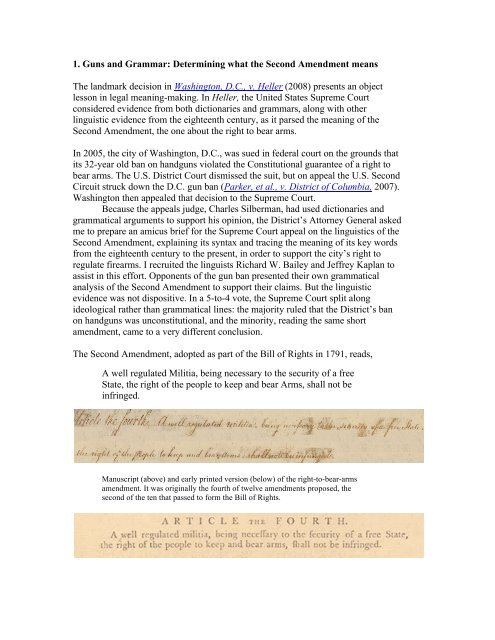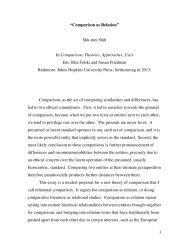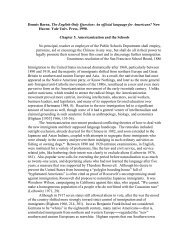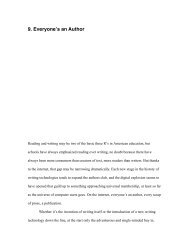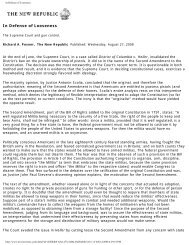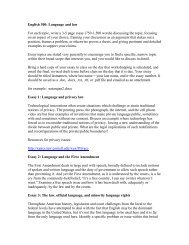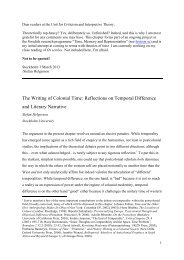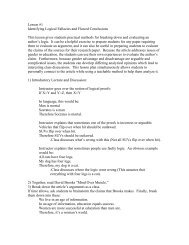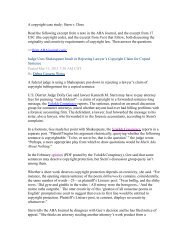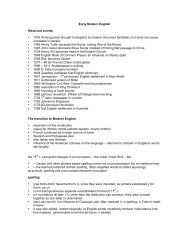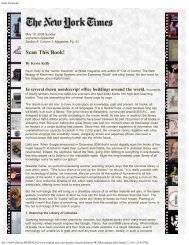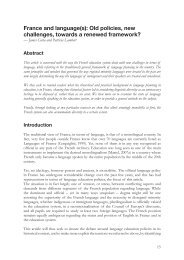1. Guns and Grammar: Determining what the Second ... - English
1. Guns and Grammar: Determining what the Second ... - English
1. Guns and Grammar: Determining what the Second ... - English
Create successful ePaper yourself
Turn your PDF publications into a flip-book with our unique Google optimized e-Paper software.
<strong>1.</strong> <strong>Guns</strong> <strong>and</strong> <strong>Grammar</strong>: <strong>Determining</strong> <strong>what</strong> <strong>the</strong> <strong>Second</strong> Amendment meansThe l<strong>and</strong>mark decision in Washington, D.C., v. Heller (2008) presents an objectlesson in legal meaning-making. In Heller, <strong>the</strong> United States Supreme Courtconsidered evidence from both dictionaries <strong>and</strong> grammars, along with o<strong>the</strong>rlinguistic evidence from <strong>the</strong> eighteenth century, as it parsed <strong>the</strong> meaning of <strong>the</strong><strong>Second</strong> Amendment, <strong>the</strong> one about <strong>the</strong> right to bear arms.In 2005, <strong>the</strong> city of Washington, D.C., was sued in federal court on <strong>the</strong> grounds thatits 32-year old ban on h<strong>and</strong>guns violated <strong>the</strong> Constitutional guarantee of a right tobear arms. The U.S. District Court dismissed <strong>the</strong> suit, but on appeal <strong>the</strong> U.S. <strong>Second</strong>Circuit struck down <strong>the</strong> D.C. gun ban (Parker, et al., v. District of Columbia, 2007).Washington <strong>the</strong>n appealed that decision to <strong>the</strong> Supreme Court.Because <strong>the</strong> appeals judge, Charles Silberman, had used dictionaries <strong>and</strong>grammatical arguments to support his opinion, <strong>the</strong> District’s Attorney General askedme to prepare an amicus brief for <strong>the</strong> Supreme Court appeal on <strong>the</strong> linguistics of <strong>the</strong><strong>Second</strong> Amendment, explaining its syntax <strong>and</strong> tracing <strong>the</strong> meaning of its key wordsfrom <strong>the</strong> eighteenth century to <strong>the</strong> present, in order to support <strong>the</strong> city’s right toregulate firearms. I recruited <strong>the</strong> linguists Richard W. Bailey <strong>and</strong> Jeffrey Kaplan toassist in this effort. Opponents of <strong>the</strong> gun ban presented <strong>the</strong>ir own grammaticalanalysis of <strong>the</strong> <strong>Second</strong> Amendment to support <strong>the</strong>ir claims. But <strong>the</strong> linguisticevidence was not dispositive. In a 5-to-4 vote, <strong>the</strong> Supreme Court split alongideological ra<strong>the</strong>r than grammatical lines: <strong>the</strong> majority ruled that <strong>the</strong> District’s banon h<strong>and</strong>guns was unconstitutional, <strong>and</strong> <strong>the</strong> minority, reading <strong>the</strong> same shortamendment, came to a very different conclusion.The <strong>Second</strong> Amendment, adopted as part of <strong>the</strong> Bill of Rights in 1791, reads,A well regulated Militia, being necessary to <strong>the</strong> security of a freeState, <strong>the</strong> right of <strong>the</strong> people to keep <strong>and</strong> bear Arms, shall not beinfringed.Manuscript (above) <strong>and</strong> early printed version (below) of <strong>the</strong> right-to-bear-armsamendment. It was originally <strong>the</strong> fourth of twelve amendments proposed, <strong>the</strong>second of <strong>the</strong> ten that passed to form <strong>the</strong> Bill of Rights.
Baron, Language <strong>and</strong> Law, <strong>1.</strong> <strong>Guns</strong> <strong>and</strong> grammar, 2For over 150 years, American courts interpreted this sentence as establishing<strong>the</strong> right of <strong>the</strong> people to possess arms when serving in <strong>the</strong> militia. This “collectiverights” interpretation underlay three Supreme Court decisions, <strong>the</strong> most recent ofwhich dates to 1939 (United States v. Miller 307 U.S. 174 [1939]). Miller had beenconvicted of transporting an unregistered sawed-off shotgun across state lines inviolation of a federal firearms law. He challenged <strong>the</strong> constitutionality of that law,<strong>and</strong> a lower court agreed. But <strong>the</strong> Supreme Court ruled that <strong>the</strong> <strong>Second</strong> Amendmentapplies to arms for military service, <strong>and</strong> Miller’s weapon did not come under itsauspices:In <strong>the</strong> absence of any evidence tending to show that possession or useof a “shotgun having a barrel of less than eighteen inches in length” atthis time has some reasonable relationship to <strong>the</strong> preservation orefficiency of a well regulated militia, we cannot say that <strong>the</strong> <strong>Second</strong>Amendment guarantees <strong>the</strong> right to keep <strong>and</strong> bear such an instrument.Certainly it is not within judicial notice that this weapon is any part of<strong>the</strong> ordinary military equipment, or that its use could contribute to <strong>the</strong>common defense.from <strong>the</strong> opinion in Miller by Justice McReynoldsThe collective rights interpretation also came into play in Parker: In hisopinion Judge Silberman notes that <strong>the</strong> lower court dismissed Parker’s initialcomplaint because<strong>the</strong> <strong>Second</strong> Amendment, at most, protects an individual’s right to“bear arms for service in <strong>the</strong> Militia” . . . . And, by “Militia,” <strong>the</strong> courtconcluded <strong>the</strong> <strong>Second</strong> Amendment referred to an organized militarybody—such as a National Guard unit.Parker v. Washington, D.C. (2007), 5But in 1960, opponents of gun control began asserting an alternate, individualrights interpretation, which ignored <strong>the</strong> militia clause <strong>and</strong> stressed every American’sright to tote a gun regardless of military service. In a rhetorical coup, <strong>the</strong>y evenstarted calling this new reading <strong>the</strong> “st<strong>and</strong>ard model,” as if <strong>the</strong> older collective rightsmodel had never existed (Bogus 2000b). The Appeals Court used this individualrights interpretation to rule Washington’s gun ban unconstitutional, arguing that <strong>the</strong>people referred to in <strong>the</strong> <strong>Second</strong> Amendment are individual citizens, a readingconsistent with interpretations of <strong>the</strong> people in <strong>the</strong> First <strong>and</strong> Fourth Amendments.Silberman exp<strong>and</strong>s on <strong>the</strong> Amendment’s semantics with definitions of keep <strong>and</strong> bearfrom <strong>the</strong> dictionaries of Samuel Johnson (1755) <strong>and</strong> Noah Webster (1828), <strong>and</strong> healludes to collections of newspaper <strong>and</strong> o<strong>the</strong>r writing of <strong>the</strong> time to maintain that,although <strong>the</strong> <strong>Second</strong> Amendment does connect bearing arms with <strong>the</strong> militia, <strong>the</strong>idiom bear arms does not refer just to soldiering:The term “bear Arms” is obviously susceptible to a militaryconstruction. But it is not accurate to construe it exclusively so.
Baron, Language <strong>and</strong> Law, <strong>1.</strong> <strong>Guns</strong> <strong>and</strong> grammar, 3Parker v. Washington, D.C. (2007), 24This interpretation is later echoed in Justice Scalia’s opinion in Heller (see below).Silberman also stresses <strong>the</strong> fundamental right of self defense. Although selfdefense is commonly recognized as a pre-existing, natural right affirmed by commonlaw <strong>and</strong> later by <strong>the</strong> <strong>Second</strong> Amendment, <strong>the</strong>re is also a long history of armsregulation in <strong>English</strong> law suggesting that self-defense is one thing, arms possessionis ano<strong>the</strong>r. Engl<strong>and</strong> has had strict weapons control since <strong>the</strong> 14 th -century, when lawsbegan stipulating that guns were for <strong>the</strong> wealthy, not <strong>the</strong> peasants or <strong>the</strong> middle class(Schwoerer 2000). The <strong>English</strong> Bill of Rights of 1689 is often cited by Americangun lobbyists as guaranteeing everyone’s right to bear arms <strong>and</strong> is referred to as wellin Parker <strong>and</strong> in Heller. But <strong>the</strong> <strong>English</strong> Bill of Rights limited weapons ownership toProtestants, provided <strong>the</strong>y belonged to <strong>the</strong> right social class, <strong>and</strong> it acknowledged <strong>the</strong>role of <strong>the</strong> law in fur<strong>the</strong>r regulating weapons: “That <strong>the</strong> Subjects which areProtestants may have Armes for <strong>the</strong>ir Defence suitable to <strong>the</strong>ir Conditions <strong>and</strong> asallowed by Law” (emphasis added).Above: Excerpt from <strong>the</strong> manuscript copy of <strong>the</strong> <strong>English</strong> Bill of Rights, 1689.British National Archives(http://www.nationalarchives.gov.uk/pathways/citizenship/rise_parliament/docs/bill_rights.htm). Below: Excerpt from <strong>the</strong> statement of rights as printed in 1689 (An actdeclaring <strong>the</strong> rights <strong>and</strong> liberties of <strong>the</strong> subject . . . , p. 5).In addition to interpreting words like “<strong>the</strong> people” <strong>and</strong> “bear arms,” JudgeSilberman concluded that its syntactic structure divided <strong>the</strong> amendment into a“prefatory” militia clause <strong>and</strong> an “operative” second clause: <strong>the</strong> first was a bit ofconstitutional throat-clearing that had no bearing on <strong>the</strong> right to bear arms. And so heruled that <strong>the</strong> operative clause prevented <strong>the</strong> city of Washington from imposing anabsolute ban on h<strong>and</strong>guns.The case was renamed District of Columbia v. Heller because <strong>the</strong> court ruledthat of <strong>the</strong> original plaintiffs, only Dick Anthony Heller, a D.C. special police officerwho had been denied a h<strong>and</strong>gun permit, had st<strong>and</strong>ing. In <strong>the</strong> appeal to <strong>the</strong> U.S.Supreme Court, opponents of gun control argued in part that <strong>the</strong>re are linguisticreasons for dismissing <strong>the</strong> first part of <strong>the</strong> <strong>Second</strong> Amendment, <strong>and</strong> <strong>the</strong>y interpreted
Baron, Language <strong>and</strong> Law, <strong>1.</strong> <strong>Guns</strong> <strong>and</strong> grammar, 4<strong>the</strong> meanings of <strong>the</strong> phrase bear arms <strong>and</strong> <strong>the</strong> word militia in ways that support <strong>the</strong>ircause. In contrast, supporters of gun control who focused on its linguistics insistedthat eighteenth-century readers would have seen <strong>the</strong> <strong>Second</strong> Amendment not as atwo-part sentence where only <strong>the</strong> second part counts, but as a balanced <strong>and</strong> unifiedstatement where militia refers to a select group of citizen soldiers, <strong>and</strong> bear armsmeans ‘engage in military activity.’In support of <strong>the</strong> District of Columbia’s appeal to reverse that lower courtruling, <strong>the</strong> Linguists’ Brief presented historical linguistic evidence arguing,<strong>1.</strong> that <strong>the</strong> <strong>Second</strong> Amendment was intended to be read in its entirety;2. that <strong>the</strong> first part of <strong>the</strong> amendment is both syntactically <strong>and</strong> semantically tiedto <strong>the</strong> second;3. that <strong>the</strong> first part of <strong>the</strong> amendment specifies <strong>the</strong> reason for <strong>the</strong> second: <strong>the</strong>right to keep <strong>and</strong> bear arms is tied directly to <strong>the</strong> need for a well-regulatedmilitia;4. that <strong>the</strong> phrase bear arms in <strong>the</strong> 18 th century occurs in military contexts, notones that involve hunting or self defense;5. <strong>and</strong> that <strong>the</strong> word militia refers in <strong>the</strong> federal period to an organized <strong>and</strong>trained body of citizen-soldiers, not to any <strong>and</strong> all Americans, many of whomwere ineligible for militia service.The punctuation <strong>and</strong> syntax of <strong>the</strong> <strong>Second</strong> Amendment Reading <strong>the</strong> <strong>Second</strong> Amendment as a statement in which every word counts followsfrom Chief Justice John Marshall’s opinion in Marbury v. Madison (1803) that “itcannot be presumed that any clause in <strong>the</strong> constitution is intended to be withouteffect.” But even without that ruling, it would have been clear to eighteenth-centuryreaders that <strong>the</strong> first part of <strong>the</strong> Amendment was bound to <strong>the</strong> second in a cause-<strong>and</strong>effectrelationship, that <strong>the</strong> right to bear arms was tied by <strong>the</strong> framers directly to <strong>the</strong>need for a well-regulated militia.In his opinion in Parker, Judge Silberman pays particular attention to <strong>the</strong><strong>Second</strong> Amendment’s punctuation: “The provision’s second comma divides <strong>the</strong>Amendment into two clauses; <strong>the</strong> first is prefatory, <strong>and</strong> <strong>the</strong> second operative”(Parker, 13; technically, <strong>the</strong> first part of <strong>the</strong> Amendment is a phrase, not a clause).Despite <strong>the</strong> popular myth that punctuation can mean <strong>the</strong> difference betweenlife <strong>and</strong> death, or at least it can cost one a lot of money, we should not give <strong>the</strong><strong>Second</strong> Amendment’s punctuation undue weight. Eighteenth-century punctuationwas variable, not rigid. Here are some examples from <strong>the</strong> Constitution itself. In Art.I, sec. 10, <strong>the</strong> framers write it’s for <strong>the</strong> possessive form of it:No state shall, without <strong>the</strong> consent of <strong>the</strong> Congress, lay any impostsor duties on imports or exports, except <strong>what</strong> may be absolutelynecessary for executing it’s inspection laws.This is not a scrivener’s error but a common usage of <strong>the</strong> time. Modern practicewould require its, <strong>and</strong> a student writing it’s for its today would be marked wrong.
Baron, Language <strong>and</strong> Law, <strong>1.</strong> <strong>Guns</strong> <strong>and</strong> grammar, 6But that’s not all. Apparently, some copies of <strong>the</strong> <strong>Second</strong> Amendment sent tosome of <strong>the</strong> states for ratification had a different number of commas from <strong>the</strong>“official” version as printed by <strong>the</strong> federal government (Van Alstyne 2007). The textof <strong>the</strong> <strong>Second</strong> Amendment quoted in Parker contains only <strong>the</strong> first two commas, not<strong>the</strong> third. But that should pose no problem, even for a strict constructionist.Punctuation only loosely correlated with meaning in <strong>the</strong> eighteenth century, <strong>and</strong> itwould not be an exaggeration to claim that <strong>the</strong> <strong>Second</strong> Amendment would mean <strong>the</strong>same thing—not just when it was written but today as well—whe<strong>the</strong>r it had one,two, or three commas, or none at all.Commentators have paid more attention to <strong>the</strong> <strong>Second</strong> Amendment’s syntaxthan to its punctuation. The amendment begins with <strong>what</strong> grammarians call anabsolute phrase: “a well regulated militia, being necessary to <strong>the</strong> security of a freestate….” Judge Silberman doesn’t call <strong>the</strong> “prefatory” phrase an absolute, but hisargument tracks that of Nelson Lund in his own discussion of <strong>the</strong> <strong>Second</strong>Amendment’s “preambulatory” absolute (Lund 2007). Lund, whose expertise is law,not language, <strong>and</strong> who filed an amicus brief supporting an individual rightsinterpretation, insists that an absolute is grammatically independent from asentence’s main clause, <strong>and</strong> so can have no impact on <strong>the</strong> meaning of that sentence.Commenting during oral arguments in Heller, Justice Kennedy similarlydisconnected <strong>the</strong> two halves of <strong>the</strong> amendment, though without dismissing <strong>the</strong>importance of a militia:[T]here is an interpretation of <strong>the</strong> <strong>Second</strong> Amendment . . . thatconforms <strong>the</strong> two clauses <strong>and</strong> in effect delinks <strong>the</strong>m. . . . Theamendment says we reaffirm <strong>the</strong> right to have a militia, we’veestablished it, but in addition, <strong>the</strong>re is a right to bear arms.”[Supreme Court 2008, 5-6]But this line of reasoning mistakes <strong>the</strong> meaning of grammatical independence.Although it is true that <strong>the</strong> second comma divides <strong>the</strong> sentence syntactically, it iscertainly not <strong>the</strong> case that such punctuation creates semantic or even syntacticindependence. And <strong>the</strong> comma does not divide <strong>the</strong> unimportant from <strong>the</strong> significantparts of a sentence, ei<strong>the</strong>r in <strong>the</strong> eighteenth century or today. An examination ofabsolute constructions in <strong>English</strong> shows that, pace Justice Kennedy, <strong>the</strong>y shouldnever be delinked.So <strong>what</strong>’s an absolute when it’s at home? The grammarian C. T. Onions writes that a phrase is called absolute “[Lat.,absolutus = free] because…it seems to be free of <strong>the</strong> rest of <strong>the</strong> sentence” (Onions1904, 66; emphasis added). Seems is <strong>the</strong> operative word here. Grammaticalindependence is not semantic independence. The opposite of independence, ingrammar is also called governance, <strong>and</strong> that in turn is a reference to one wordcontrolling <strong>the</strong> grammatical case of ano<strong>the</strong>r. As Bishop Lowth put it in his influential
Baron, Language <strong>and</strong> Law, <strong>1.</strong> <strong>Guns</strong> <strong>and</strong> grammar, 7grammar of 1762, “Regimen, or government, is when a word causeth a followingword to be in some case, or mode” (Lowth 1762, 95).The grammarian Robert Lowth’s explanation of syntactic “government”: a wordthat controls <strong>the</strong> case of ano<strong>the</strong>r word (from A short introduction to <strong>English</strong>grammar, 176)In Lowth’s day, <strong>English</strong> absolutes took <strong>the</strong> nominative case, sometimes alsocalled <strong>the</strong> ungoverned case, <strong>and</strong> so <strong>the</strong>y appeared to be grammatically independent.But that’s because Modern <strong>English</strong> nouns had lost most case markings. In Old<strong>English</strong>, <strong>the</strong> nouns in absolutes took <strong>the</strong> dative case (cf. <strong>the</strong> Latin ablative absolute),marking <strong>the</strong> subordination of <strong>the</strong> absolute to <strong>the</strong> main clause of <strong>the</strong> sentence. Thegrammatical independence of <strong>the</strong> absolute is merely apparent, not real, <strong>the</strong> accidentof a morphological change, not a syntactic or semantic one. Henry Fowler (1906,228) succinctly underscores <strong>the</strong> distinction between grammatical <strong>and</strong> semanticindependence in pointing out <strong>the</strong> clear semantic connection that frequently existseven between independent sentences separated by a full stop: “There aregrammatical dependence, <strong>and</strong> dependence of thought.”William Ward (1767, 145) shows just how important <strong>the</strong> absolute is when hecalls it <strong>the</strong> equivalent of a whole sentence, <strong>and</strong> he discusses absolutes both in termsof <strong>the</strong>ir internal dependence <strong>and</strong> <strong>the</strong>ir dependence on <strong>the</strong> rest of <strong>the</strong> sentence. GooldBrown, compiler of a comprehensive grammar, similarly makes clear that <strong>the</strong>absolute “is often equivalent to a dependent clause commencing with when, while,if, since, or because.” (1880, 536). Lyndley Murray (1795, 162-63), whose grammarwas widely used in American schools, demonstrates <strong>the</strong> obvious cause-<strong>and</strong>-effectfunction of <strong>the</strong> absolute, even as it is “separated by commas from <strong>the</strong> body of <strong>the</strong>sentence,” with this example: “His fa<strong>the</strong>r dying, he succeeded to <strong>the</strong> estate.” InMurray’s example, <strong>the</strong> effect cannot easily be “delinked” from <strong>the</strong> cause.Above: William Ward (1767) describes <strong>the</strong> absolute as <strong>the</strong> “equivalent to a wholeSentence.” Below: Lyndley Murray (1795), in his tenth rule of syntax, demonstrates<strong>the</strong> clear cause-<strong>and</strong>-effect function of <strong>the</strong> absolute: “His fa<strong>the</strong>r dying, he succeededto <strong>the</strong> estate.” In this example, <strong>the</strong> effect cannot be “delinked” from <strong>the</strong> cause.
Baron, Language <strong>and</strong> Law, <strong>1.</strong> <strong>Guns</strong> <strong>and</strong> grammar, 8Reading <strong>the</strong> <strong>Second</strong> Amendment’s absolute as a reduced cause-<strong>and</strong>-effectsentence, we can express <strong>the</strong> interdependence of <strong>the</strong> Amendment’s two parts thisway: ‘Because a well-regulated militia is necessary to <strong>the</strong> security of a free State, <strong>the</strong>right of <strong>the</strong> people to keep <strong>and</strong> bear Arms shall not be infringed.’Onions (1904, 69) finds that although absolutes were relatively rare in earlierperiods of <strong>English</strong>, by <strong>the</strong> seventeenth century <strong>the</strong> absolute had become thoroughlynaturalized, offering “an important . . . resource [to] all writers . . . for <strong>the</strong> purpose ofexpressing subordinate conceptions.”Americans had probably seen <strong>the</strong>ir share of absolutes long before <strong>the</strong>y read<strong>the</strong> <strong>Second</strong> Amendment. They might even have been tested on it in grammar schoolin some federalist version of “No Child Left Behind.” But even without formalschooling, eighteenth-century Americans would have had no trouble underst<strong>and</strong>ing<strong>the</strong> absolute that specifies <strong>the</strong> reason for establishing l<strong>and</strong>-grant public colleges inArticle 3 of <strong>the</strong> Northwest Ordinance of 1787:Religion, morality, <strong>and</strong> knowledge, being necessary to goodgovernment <strong>and</strong> <strong>the</strong> happiness of mankind, schools <strong>and</strong> <strong>the</strong> means ofeducation shall forever be encouraged.Article 3 of <strong>the</strong> Northwest Ordinance of 1787 opens with an absolute: “Religion,morality, <strong>and</strong> knowledge, being necessary to good government <strong>and</strong> <strong>the</strong> happiness ofmankind, schools <strong>and</strong> <strong>the</strong> means of education shall forever be encourage.The absolute was certainly familiar to James Madison, who drafted <strong>the</strong><strong>Second</strong> Amendment <strong>and</strong> who used absolute constructions elsewhere in his writings.Here are but two of many Madisonian absolutes:[T]he Executive power being in general terms vested in <strong>the</strong> President,all power of an Executive nature, not particularly taken away mustbelong to that department, that <strong>the</strong> power of appointment only beingexpressly taken away, <strong>the</strong> power of Removal, so far as it is of anExecutive nature must be reserved.[Letter to Edmund Pendleton, New York, June 21, 1789.]That, being a compact among <strong>the</strong> States in <strong>the</strong>ir highest sovereigncapacity, <strong>and</strong> constituting <strong>the</strong> people <strong>the</strong>reof one people for certainpurposes, it is not revocable or alterable at <strong>the</strong> will of <strong>the</strong> States
Baron, Language <strong>and</strong> Law, <strong>1.</strong> <strong>Guns</strong> <strong>and</strong> grammar, 9individually, as <strong>the</strong> constitution of a State is revocable & alterable atits individual will.[Letter to M. L. Hurlbert, Mad. Mss., Montpr. May 1830.]Madison would not have used absolutes in his essays, in his correspondence,in <strong>the</strong> <strong>Second</strong> Amendment, if he suspected that his readers might find <strong>the</strong>construction odd, ambiguous, or unimportant.But even if absolutes are not to be isolated from <strong>the</strong> rest of a sentence in formor meaning, Nelson Lund fur<strong>the</strong>r argues that purpose clauses of any kind are legallyirrelevant, that only operative clauses have any effect. Scalia <strong>and</strong> Garner (2012, 217)similarly acknowledge that “a preamble, purpose clause, or recital is a permissibleindicator of meaning,” though <strong>the</strong>y qualify this by adding that such prologues areasides, “not part of <strong>the</strong> congressionally legislated or privately created set of rights<strong>and</strong> duties.” Although <strong>the</strong> Constitution is not “congressionaly legislated,” in hisopinion in Heller Scalia affirms that “a prefatory clause does not limit or exp<strong>and</strong> <strong>the</strong>scope of <strong>the</strong> operative clause” (Heller, 4). But to o<strong>the</strong>r readers, <strong>the</strong> fact that <strong>the</strong><strong>Second</strong> Amendment is <strong>the</strong> only one of <strong>the</strong> first ten with a causal phrase suggests <strong>the</strong>militia clause is important, not just decorative. Eighteenth-century readers wouldhave noticed it, not ignored it. Until Heller, <strong>the</strong> Supreme Court did <strong>the</strong> same. EvenNelson Lund acknowledges as much when he calls <strong>the</strong> <strong>Second</strong> Amendment’sabsolute <strong>the</strong> amendment’s most significant grammatical feature, although he <strong>the</strong>nproceeds to tell us how insignificant it really is (2007, 12).Defining <strong>the</strong> <strong>Second</strong> Amendment’s words Along with questions about <strong>the</strong> <strong>Second</strong> Amendment’s grammatical structure, Hellerraised <strong>the</strong> issue of <strong>what</strong>, exactly, do some of its key words mean:• What did <strong>the</strong> framers mean by a militia?• What does it mean for a militia to be “well-regulated”?• Does <strong>the</strong> phrase “<strong>the</strong> people” refer to individuals or <strong>the</strong> collective polity?• What is <strong>the</strong> meaning of keep in <strong>the</strong> phrase to keep <strong>and</strong> bear arms?• What does bear mean?• What does arms refer to?• What is <strong>the</strong> meaning of bear arms?• Do <strong>the</strong> words ‘to keep arms’ <strong>and</strong> ‘to bear arms’—refer to two separateactivities? Or is keep <strong>and</strong> bear arms to be read as one single phrase?What is a well-‐regulated militia? Interpreters of <strong>the</strong> <strong>Second</strong> Amendment have skirmished over <strong>what</strong> exactly a militiais. Does it refer to an organized <strong>and</strong> trained fighting force, or does it refer to any <strong>and</strong>all individual citizens, from whom <strong>the</strong> militia is drawn? Gun rights advocates,
Baron, Language <strong>and</strong> Law, <strong>1.</strong> <strong>Guns</strong> <strong>and</strong> grammar, 10hoping to show that <strong>the</strong> <strong>Second</strong> Amendment invests individuals with <strong>the</strong> right to ownfirearms for any purpose, argue that, if <strong>the</strong> “militia clause” does indeed have somesignificance, <strong>the</strong>n <strong>the</strong>y would like militia to include everybody. Supporters of guncontrol prefer to read <strong>the</strong> <strong>Second</strong> Amendment as connecting gun ownershipspecifically with militia service. In <strong>the</strong>ir view, militia refers solely to <strong>the</strong> group ofvolunteer weekend warriors we now find in <strong>the</strong> modern National Guard, <strong>the</strong> militaryforce that evolved from <strong>the</strong> eighteenth-century American state militias.Fortunately, <strong>the</strong> Constitution itself guides us in <strong>the</strong> interpretation of militia.Article I, section 8 defines <strong>the</strong> militia <strong>and</strong> gives Congress <strong>the</strong> power “To provide forcalling forth <strong>the</strong> Militia to execute <strong>the</strong> Laws of <strong>the</strong> Union, suppress Insurrections <strong>and</strong>repel Invasions.”A well-regulated militia, <strong>the</strong> kind referred to in <strong>the</strong> <strong>Second</strong> Amendment, isnot a b<strong>and</strong> of irregulars like <strong>the</strong> Mehdi Militia, a sectarian army fighting againstgovernment troops in Iraq. It is not an impromptu posse chasing a villain with a hue<strong>and</strong> cry, as it was in medieval Engl<strong>and</strong>. It is not a collection of disgruntled whitesupremacists who reject government authority <strong>and</strong> refuse to pay taxes. It is not ahunt club. And it is not <strong>the</strong> collective body of all Americans from whom a militiamay be raised.Instead, according to <strong>the</strong> Constitution, <strong>the</strong> militia is a military forceconsisting only of those eligible to serve. In <strong>the</strong> framers day, that included ablebodiedwhite males ages 16 – 45 (sometimes, 50 or 60), not <strong>the</strong> entire group of men,women <strong>and</strong> children living in <strong>the</strong> United States, <strong>and</strong> more than a few of thosepatriots eligible to serve bought out <strong>the</strong>ir obligation or sought even more creativeways to avoid service. Since <strong>the</strong> ratification of <strong>the</strong> Constitution, <strong>the</strong> militia has alsobeen a body that has been regulated well, <strong>and</strong> constitutionally, by federal authority.This American definition of militia is in keeping with <strong>the</strong> word’s eighteenthcenturymeaning. Dr. Johnson’s Dictionary (1755, s.v.) defines militia as “<strong>the</strong>trainb<strong>and</strong>s; <strong>the</strong> st<strong>and</strong>ing force of a nation” (trainb<strong>and</strong> is a seventeenth-century term,no longer in use, for a temporary, citizen-army; while st<strong>and</strong>ing force refers to ast<strong>and</strong>ing or permanent army). Noah Webster defines militia (1828, s.v.) as,The body of soldiers in a state enrolled for discipline, but not engagedin actual service except in emergencies; as distinguished from regulartroops, whose sole occupation is war or military service. The militiaof a country are <strong>the</strong> able bodied men organized into companies,regiments <strong>and</strong> brigades, with officers of all grades, <strong>and</strong> required bylaw to attend military exercises on certain days only, but at o<strong>the</strong>rtimes left to pursue <strong>the</strong>ir usual occupations.The Oxford <strong>English</strong> Dictionary confirms this reading of militia with a citefrom Adam Smith’s Wealth of Nations (1776):[The state] may..oblige ei<strong>the</strong>r all <strong>the</strong> citizens of <strong>the</strong> military age, or acertain number of <strong>the</strong>m, to join in some measure <strong>the</strong> trade of a soldierto <strong>what</strong>ever o<strong>the</strong>r trade or profession <strong>the</strong>y may happen to carry on...Its military force is [<strong>the</strong>n] said to consist in a militia.
Baron, Language <strong>and</strong> Law, <strong>1.</strong> <strong>Guns</strong> <strong>and</strong> grammar, 11The OED also defines militia in its specifically American context: “In <strong>the</strong> U.S.: <strong>the</strong>body of able-bodied citizens eligible by law for military service. Now hist[orical]. . .. The reconstitution of <strong>the</strong> U.S. militias as <strong>the</strong> National Guard was substantiallycomplete by <strong>the</strong> beginning of <strong>the</strong> 20th cent.”The Dictionary of Americanisms defines militia as, “The whole body of adultmale citizens capable of bearing arms” <strong>and</strong> gives <strong>the</strong> following citations:1705. Beverley Virginia IV.34 Every Freeman . . . from sixteen, tosixty years of age, is listed in <strong>the</strong> militia.1800. Jefferson Notes 94 Every able bodied freeman, between <strong>the</strong>ages of 16 <strong>and</strong> 50 is enrolled in <strong>the</strong> militia.1890. Cent. 3761/2 Militia, . . . <strong>the</strong> whole body of men declared bylaw amenable to military service, without enlistment, whe<strong>the</strong>r armed<strong>and</strong> drilled or not.[Ma<strong>the</strong>ws 1951, s.v., militia]These dictionaries do not define militia to include <strong>the</strong> total body of citizens,though <strong>the</strong> last of Ma<strong>the</strong>ws’ examples, from <strong>the</strong> Century Dictionary, suggests abroader definition of militia than is typical, those “men declared by law amenable tomilitary service,” ra<strong>the</strong>r than those actually trained to serve, but even here, to be amember of <strong>the</strong> militia one must still be eligible, by law, to serve in an organizedfighting force.It is also clear that James Madison, who drafted <strong>the</strong> Bill of Rights, considered<strong>the</strong> word militia to refer to a subgroup of American citizens, albeit a large one, ra<strong>the</strong>rthan to each <strong>and</strong> every individual American. In <strong>the</strong> Federalist Papers Madison,addressing <strong>the</strong> concerns of antifederalists, envisioned a militia of citizen soldierswhose presence would keep in check any excesses of a federal government or itsst<strong>and</strong>ing army:To [this federal st<strong>and</strong>ing army of twenty-five to thirty thous<strong>and</strong>soldiers] would be opposed a militia amounting to near half a millionof citizens with arms in <strong>the</strong>ir h<strong>and</strong>s, officered by men chosen fromamong <strong>the</strong>mselves, fighting for <strong>the</strong>ir common liberties, <strong>and</strong> united<strong>and</strong> conducted by governments possessing <strong>the</strong>ir affections <strong>and</strong>confidence. It may well be doubted, whe<strong>the</strong>r a militia thuscircumstanced could ever be conquered by such a proportion ofregular troops.[Madison 1788, Federalist 46, emphasis added]By describing <strong>the</strong> militia as a force that is officered, Madison makes clearthat he is contrasting <strong>the</strong> power of a citizen army with that of a st<strong>and</strong>ing orprofessional one. But although <strong>the</strong> United States had only recently fought a waragainst an unjust government, <strong>and</strong> despite <strong>what</strong> Federalist 46 suggests, <strong>the</strong>Constitution did not constitute <strong>the</strong> militia to foment rebellion against an unjust
Baron, Language <strong>and</strong> Law, <strong>1.</strong> <strong>Guns</strong> <strong>and</strong> grammar, 12government or even to check <strong>and</strong> balance <strong>the</strong> army. Instead, <strong>the</strong> militia is a militaryarm of both <strong>the</strong> states <strong>and</strong> <strong>the</strong> federal government which may be called upon asneeded to enforce <strong>the</strong> law. As we saw when Pres. Eisenhower called out <strong>the</strong> NationalGuard to enforce federal desegregation in <strong>the</strong> Little Rock schools, or when GeorgeBush sent <strong>the</strong> National Guard to fight in Iraq, <strong>the</strong> job of <strong>the</strong> militia has always beento reinforce <strong>the</strong> st<strong>and</strong>ing army in putting down domestic insurrections <strong>and</strong> repellingforeign threats.The <strong>Second</strong> Amendment was revised <strong>and</strong> sharpened before it was finallypassed. During this editing, <strong>the</strong> militia clause was not cut from <strong>the</strong> amendment,though ano<strong>the</strong>r provision was discarded which dealt with conscientious objectors—Quakers who, though <strong>the</strong>y may have hunted for food, consistently refused to beararms. A version of <strong>the</strong> <strong>Second</strong> Amendment approved by <strong>the</strong> Senate shows a slightlydifferent wording: “a well regulated militia, being <strong>the</strong> best security of a free state,<strong>the</strong> right of <strong>the</strong> people to keep <strong>and</strong> bear arms, shall net [sic] be infringed” (Journal1789-93). The final version of <strong>the</strong> <strong>Second</strong> Amendment was rewritten yet again toread, “A well regulated Militia, being necessary to <strong>the</strong> security of a free State,”placing continued emphasis on <strong>the</strong> importance of <strong>the</strong> militia, a fur<strong>the</strong>r reason not todismiss <strong>the</strong> importance of <strong>the</strong> <strong>Second</strong> Amendment’s absolute construction.And yet that is <strong>what</strong> Justice Scalia does in his opinion. Scalia acknowledgesthat <strong>the</strong> militia is a subset of Americans, but that very fact reinforces <strong>the</strong> distinctionhe <strong>the</strong>n makes between <strong>the</strong> militia <strong>and</strong> <strong>the</strong> people:<strong>the</strong> “militia” in colonial America consisted of a subset of “<strong>the</strong>people”—those who were male, able bodied, <strong>and</strong> within a certain agerange. Reading <strong>the</strong> <strong>Second</strong> Amendment as protecting only <strong>the</strong> right to“keep <strong>and</strong> bear Arms” in an organized militia <strong>the</strong>refore fits poorlywith <strong>the</strong> operative clause’s description of <strong>the</strong> holder of that right as“<strong>the</strong> people.”We start <strong>the</strong>refore with a strong presumption that <strong>the</strong> <strong>Second</strong>Amendment right is exercised individually <strong>and</strong> belongs to allAmericans.To keep <strong>and</strong> bear arms . . . Heller, 7The militia clause survived rounds of editing by <strong>the</strong> framers only to be summarilydeleted by Justice Scalia because of its poor fit with <strong>the</strong> “operative clause.” Ano<strong>the</strong>rproblem in interpretation concerns meaning of arms, <strong>and</strong> <strong>what</strong> it means to bear<strong>the</strong>m. From <strong>the</strong> discussions in oral arguments as well as in Justice Scalia’s opinion<strong>and</strong> Justice Stevens’ dissent, it’s apparent that <strong>the</strong> justices define <strong>the</strong> bearing of armsin ways that support <strong>the</strong>ir overall sense of <strong>what</strong> <strong>the</strong> <strong>Second</strong> Amendment guarantees,<strong>and</strong> <strong>what</strong> it does not. In this section, we’ll look specifically at how dictionaries cameinto play to answer some of <strong>the</strong>se questions.Given that <strong>the</strong> <strong>Second</strong> Amendment guarantees a right related to arms, <strong>the</strong>justices took care to consider <strong>what</strong> arms might mean in <strong>the</strong> framers’ day, <strong>and</strong> <strong>what</strong> itrefers to today. Along with <strong>the</strong> dictionaries of Samuel Johnson <strong>and</strong> Noah Webster,
Baron, Language <strong>and</strong> Law, <strong>1.</strong> <strong>Guns</strong> <strong>and</strong> grammar, 13Justice Scalia cited Timothy Cunningham’s New <strong>and</strong> Complete Law Dictionary(1771), where arms is defined as “any thing that a man wears for his defence, ortakes into his h<strong>and</strong>s, or useth in wrath to cast at or strike ano<strong>the</strong>r.” Variations on thisdefinition occur in <strong>English</strong> legal texts going back to <strong>the</strong> 14th century: Henry Bracton(III: 20) writes,non solum si quis venerit cum telis, verum etiam omnes illos dicimusarmatos qui habent quod nocere potest. Telorum autem appellationeomnia in quibus singuli homines nocere possunt accipiuntur. Sed siquis venerit sine armis et in ipsa concertatione ligna sumpserit, fusteset lapides, talis dicetur vis armata.not only if one comes with weapons [is he armed], we regard asarmed all those who have anything that may cause injury. All thingsby which men may inflict injury are included in <strong>the</strong> word ‘weapons.’If one comes unarmed, but during <strong>the</strong> course of <strong>the</strong> argument picksup sticks, staves [or] stones, it will be called armed force.And John Cowell, in his legal dictionary (1701), echoing Bracton, writes that<strong>the</strong> meaning of arms <strong>and</strong> armor extends “to any thing that a Man in his wrath or furytaketh into his h<strong>and</strong>, or wears for a defence, wherewith to cast at or strike ano<strong>the</strong>r.”In his dissent, Justice Stevens cited both Samuel Johnson’s definition of armsas “weapons of offence, or armour of defence” (1755) <strong>and</strong> John Trusler’s “by arms,we underst<strong>and</strong> those instruments of offence generally made use of in war; such asfirearms, swords, &c.” (1794).truslerarms.jpgJohn Trusler defines arms as “those instruments of offence generally made use of inwar.” The Distinction Between Words Esteemed Synonymous in <strong>the</strong> <strong>English</strong>Language, 37 (1794).Cunningham’s definition is general: arms include knives <strong>and</strong> guns as well assticks <strong>and</strong> stones <strong>and</strong> broken bottle necks. Trusler’s is narrower, referring primarilyto instruments of war. Scalia, who discounted <strong>the</strong> militia clause <strong>and</strong> foundWashington’s h<strong>and</strong>gun restrictions overbroad, preferred Cunningham’s definitionbecause it’s not tied to military weapons, but covers just about anything that can beused offensively or defensively. Stevens, who read <strong>the</strong> militia clause as directlyinforming <strong>the</strong> amendment’s guarantee, preferred Trusler’s definition because itfocuses on weapons of war suitable for militia use. None of <strong>the</strong> definitions cited refer
Baron, Language <strong>and</strong> Law, <strong>1.</strong> <strong>Guns</strong> <strong>and</strong> grammar, 14to arms used in hunting or for target practice, though some weapons advocates insistthat <strong>the</strong> <strong>Second</strong> Amendment covers <strong>the</strong>se as well.Bearing arms Sometimes <strong>the</strong> justices can’t find <strong>the</strong> support <strong>the</strong>y’re looking for in dictionaries, <strong>and</strong>when a judicial interpretation of a law clashes with <strong>the</strong> lexical evidence, <strong>the</strong>y mayreject <strong>the</strong> authority of <strong>the</strong> same dictionaries that in o<strong>the</strong>r cases <strong>the</strong>y hold up asrepositories of wisdom <strong>and</strong> reason. In Heller, none of <strong>the</strong> justices thought that <strong>the</strong><strong>Second</strong> Amendment protected a citizen’s right to own a tank or a surface-to-airmissile, even though such weapons fit <strong>the</strong> definition of arms as ‘weapons of war.’But <strong>the</strong>y did argue over <strong>the</strong> meaning of <strong>the</strong> phrase bear arms, specifically, whe<strong>the</strong>r<strong>the</strong> amendment protects <strong>the</strong> right to bear arms in connection with military service.The Court’s conservative majority decided that it did not, that it also guaranteed <strong>the</strong>right to bear arms for hunting <strong>and</strong> self-defense as well.Dictionaries, however, show that from <strong>the</strong> 18th century to <strong>the</strong> present, <strong>the</strong>phrase bear arms typically appears in military contexts, not ones involvingindividual self-defense, hunting, or sport. As <strong>the</strong> historian Garry Wills put it, “Onedoes not bear arms against a rabbit.” But Justice Scalia rejected <strong>the</strong> dictionaryevidence that did not support his underst<strong>and</strong>ing of <strong>the</strong> <strong>Second</strong> Amendment, writingin his majority opinion, that although bear arms often occurred in military contexts,“<strong>the</strong> fact that <strong>the</strong> phrase [bear arms] was commonly used in a particular context doesnot show that it is limited to that context” (Heller, 15). In o<strong>the</strong>r words, one canindeed bear arms when hunting rabbit.Bear arms (a direct translation from <strong>the</strong> Latin arma fero) typically refers to <strong>the</strong> act ofsoldiering <strong>and</strong> <strong>the</strong> use of military weapons. The most pertinent American referenceto bearing arms before <strong>the</strong> <strong>Second</strong> Amendment is its use in <strong>the</strong> Declaration ofIndependence:The present King of Great Britain . . . has constrained our fellowcitizens . . . to bear arms against <strong>the</strong>ir country.In his legal dictionary, John Cowell (1701) writes that <strong>the</strong> meaning of arms<strong>and</strong> armor extends “to any thing that a Man in his wrath or fury taketh into his h<strong>and</strong>,or wears for a defence, wherewith to cast at or strike ano<strong>the</strong>r.” However, while armsmay be anything from Saturday night specials <strong>and</strong> brass knuckles to broken beerbottles <strong>and</strong> baseball bats, <strong>the</strong> idiomatic phrase bear arms has always primarily meant‘to go for a soldier,’ as in this example from a proclamation made by Josiah Martin,<strong>the</strong> British governor of North Carolina, in 1776:I do hereby . . . promise, <strong>and</strong> assure, to each <strong>and</strong> every Person orPersons who shall join His MAJESTY’S Forces <strong>and</strong> bear Arms against<strong>the</strong> Rebels in this Province . . . a Grant . . . of L<strong>and</strong> in Proportion to<strong>the</strong>ir Circumstances, Merit <strong>and</strong> Pretensions.[Martin 1776]
Baron, Language <strong>and</strong> Law, <strong>1.</strong> <strong>Guns</strong> <strong>and</strong> grammar, 15Far less commonly, bear arms may refer to individuals carrying weapons, asin this isolated example from 1645: “There shall be a cessation of bearing of armesvnto <strong>the</strong> meeting howse vpon <strong>the</strong> Lord’s daye” (Craigie 1938, s.v. arm). In oralarguments in Heller, Justice Scalia referred to a 1716 Parliamentary act fordisarming <strong>the</strong> Scottish Highl<strong>and</strong>ers to underscore his belief that ‘bear arms’ regularlyrefers to carrying weapons in nonmilitary contexts:[A]s I recall <strong>the</strong> legislation against Scottish highl<strong>and</strong>ers <strong>and</strong> against–against Roman Catholics did use <strong>the</strong> term–forbade <strong>the</strong>m to keep <strong>and</strong>bear arms, <strong>and</strong> <strong>the</strong>y weren't just talking about <strong>the</strong>ir joining militias;<strong>the</strong>y were talking about whe<strong>the</strong>r <strong>the</strong>y could have arms.But <strong>what</strong> <strong>the</strong> Highl<strong>and</strong>er statute actually says is[Supreme Court 2008, 17]that . . . it should not be lawful for any Persons . . . to have in . . . <strong>the</strong>irCustody, use or bear, Broad Sword . . . Side-Pistol. . . or Gun, or anyo<strong>the</strong>r warlike Weapons, in <strong>the</strong> Fields, or in <strong>the</strong> Way coming or goingto, from or at any Church, Market, Fair, Burials, Huntings, Meetingsor any o<strong>the</strong>r occasion <strong>what</strong>soever.This act bans “warlike” weapons from public ga<strong>the</strong>rings, <strong>and</strong> its goal is todisarm <strong>the</strong> population in order to end organized rebellion against <strong>the</strong> crown. Ithampered hunting <strong>and</strong> self-defense as well, which produced fur<strong>the</strong>r Scottishantipathy toward Engl<strong>and</strong>, but that was not its primary intent.The opponents of gun control also make much of <strong>the</strong> minority view ofPennsylvania antifederalists, who wanted a Bill of Rights attached to <strong>the</strong>Constitution, <strong>and</strong> who tried unsuccessfully to extend bear arms in that Bill of Rightsto include not just protecting <strong>the</strong> state, but also hunting <strong>and</strong> self defense:That <strong>the</strong> people have a right to bear arms for <strong>the</strong> defense of<strong>the</strong>mselves <strong>and</strong> <strong>the</strong>ir own state, or <strong>the</strong> United States, or for <strong>the</strong>purpose of killing game.[Address 1787, 6; emphasis added]But even <strong>the</strong>ir proposal recognizes <strong>the</strong> need to regulate weapons for <strong>the</strong>public good: “No law shall be passed for disarming <strong>the</strong> people or any of <strong>the</strong>m, unlessfor crimes committed, or real danger of public injury from individuals.”Pennsylvania ratified <strong>the</strong> federal Constitution without a Bill of Rights, but itdid write one into its own state constitution in 1790: “The right of <strong>the</strong> citizens to bear
Baron, Language <strong>and</strong> Law, <strong>1.</strong> <strong>Guns</strong> <strong>and</strong> grammar, 16arms for <strong>the</strong> defence of <strong>the</strong>mselves <strong>and</strong> <strong>the</strong> state shall not be questioned.” Similarlanguage is found in Ohio’s 1802 constitution (Davis 1823, 91; 179).Whe<strong>the</strong>r <strong>the</strong> Pennsylvania <strong>and</strong> Ohio state constitutions, which appeared after<strong>the</strong> <strong>Second</strong> Amendment was drafted, but before it was adopted, seek to remedy aConstitutional defect by applying <strong>the</strong> right to bear arms to individuals, or <strong>the</strong>ysimply wish to extend <strong>the</strong> notion of bearing arms beyond its normal military use,such specification was unusual <strong>and</strong> did not reflect <strong>the</strong> ordinary meaning of <strong>the</strong> phraseto bear arms, as it appears, for example, in <strong>the</strong> Massachusetts constitution: “Thepeople have a right to keep <strong>and</strong> to bear arms for <strong>the</strong> common defence” (Freeman1805, 11). Freeman elaborates fur<strong>the</strong>r in his discussion of <strong>the</strong> civil rights <strong>and</strong>liberties of Massachusetts citizens:The fifth auxiliary right of <strong>the</strong> subject, that I shall at present mention,is that of having arms for <strong>the</strong>ir defence, suitable to <strong>the</strong>ir condition <strong>and</strong>degree, <strong>and</strong> such as are allowed by law. Which . . . is indeed a publicallowance, under due restrictions, of <strong>the</strong> natural right of resistance<strong>and</strong> self-preservation, when <strong>the</strong> sanctions of society <strong>and</strong> laws arefound insufficient to restrain <strong>the</strong> violence of oppression.[Freeman 1805, 473]Freeman’s words echo those of <strong>the</strong> <strong>English</strong> Bill of Rights <strong>and</strong> emphasize bothgovernmental control of arms <strong>and</strong> <strong>the</strong> value of community self defense, which heexplains in <strong>the</strong> language of a just revolution, not <strong>the</strong> language of keeping one’s home<strong>and</strong> person safe from criminal attack: It is “a public allowance, under duerestrictions, of <strong>the</strong> natural right of resistance <strong>and</strong> self-preservation, when <strong>the</strong>sanctions of society <strong>and</strong> laws are found insufficient to restrain <strong>the</strong> violence ofoppression” (Freeman 1805, 473). This is much <strong>the</strong> same sentiment that Madisonexpressed in Federalist 46, where he argued that armed citizens would serve as acheck on <strong>the</strong> federal government.freemanbeararms.jpgWhat’s important for Constitutional interpretation is <strong>the</strong> fact that <strong>the</strong> finalversion of <strong>the</strong> <strong>Second</strong> Amendment, while it recognizes <strong>the</strong> connection between arms<strong>and</strong> a well-regulated militia, makes no mention of bearing arms “for <strong>the</strong> defense of[individuals] . . . or for <strong>the</strong> purpose of killing game,” <strong>and</strong> so <strong>the</strong> Pennsylvaniaminority opinion was ei<strong>the</strong>r ignored or rejected by <strong>the</strong> framers of <strong>the</strong> federalConstitution, <strong>and</strong> by <strong>the</strong> states. Supporters of an individual right to bear arms mayargue that <strong>the</strong> Constitution implies such a right, or that its silence on <strong>the</strong> subjectmeans that <strong>the</strong> existence of a prior natural right to own weapons was so obvious to
Baron, Language <strong>and</strong> Law, <strong>1.</strong> <strong>Guns</strong> <strong>and</strong> grammar, 17everyone that <strong>the</strong>re was no need to mention it in <strong>the</strong> Amendment. But <strong>the</strong>ir argumentthat bearing arms in hunting <strong>and</strong> self-defense is idiomatic <strong>English</strong> is not supportedby textual evidence from <strong>the</strong> eighteenth century or earlier.Nineteenth- <strong>and</strong> twentieth-century dictionaries also confirm that bear armsrefers to military service or <strong>the</strong> sorts of self defense for which a militia is organized.But after groups like <strong>the</strong> National Rifle Association flooded <strong>the</strong> language with prosein which bear arms becomes a synonym for carrying guns, Webster’s Third (1961,s.v. bear) ab<strong>and</strong>oned that traditional military restriction <strong>and</strong> redefined <strong>the</strong> phrasemore generally as “to carry or possess arms,” with <strong>the</strong> <strong>Second</strong> Amendment cited toillustrate <strong>the</strong> definition.Above: Oxford <strong>English</strong> Dictionary entry for ‘bear arms’ Below, Webster’s ThirdNew International Dictionary entry for <strong>the</strong> phrase.w3beararms.jpgBut despite <strong>the</strong> insistence of gun rights advocates, <strong>the</strong> idiom bear arms doesnot stretch comfortably to accommodate this meaning. In oral arguments in Heller,Justice Souter challenged Solicitor General Paul Clement on <strong>the</strong> meaning of beararms. When Clement interpreted bear arms as ‘to carry <strong>the</strong>m outside <strong>the</strong> home,’Souter asked, “But wait a minute. You’re not saying that if somebody goes huntingdeer he is bearing arms, or are you?” Clement replied, “I would say that <strong>and</strong> sowould Madison <strong>and</strong> so would Jefferson.”But Souter wasn’t convinced. He asked, “In <strong>the</strong> eighteenth century, someonegoing out to hunt a deer would have thought of <strong>the</strong>mselves as bearing arms? I mean,is that <strong>the</strong> way <strong>the</strong>y talk?” Clement finally conceded that was not <strong>the</strong> way <strong>the</strong>ytalked: “Well, I will grant you this, that ‘bear arms’ in its unmodified form is mostnaturally understood to have a military context.”
Baron, Language <strong>and</strong> Law, <strong>1.</strong> <strong>Guns</strong> <strong>and</strong> grammar, 18Justice Scalia disagreed. In his opinion, Scalia argues that bear arms ismilitary when accompanied by <strong>the</strong> preposition, as in bear arms against. By itself,bear arms can simply refer to carrying weapons for self defense, <strong>and</strong> he cites insupport of this an earlier dissent by Justice Ginsberg in Muscarello v. United States(1998, 143). That case turned on <strong>the</strong> meaning of carrying firearms, <strong>and</strong> in her dissentGinsburg wrote, “[s]urely a most familiar meaning is, as <strong>the</strong> Constitution’s <strong>Second</strong>Amendment . . . indicate[s]: ‘wear, bear, or carry . . . upon <strong>the</strong> person or in <strong>the</strong>clothing or in a pocket, for <strong>the</strong> purpose . . . of being armed <strong>and</strong> ready for offensive ordefensive action in a case of conflict with ano<strong>the</strong>r person’” (<strong>the</strong> definition is fromBlack’s Law Dictionary, 143). It’s important for our analysis that, although Ginsburgcites <strong>the</strong> <strong>Second</strong> Amendment in Muscarello, she’s citing Black’s definition of carryarms. In contrast, Black’s definition of bear arms stresses <strong>the</strong> military associationsof <strong>the</strong> phrase: “to carry arms as weapons <strong>and</strong> with reference to <strong>the</strong>ir military use.”Never<strong>the</strong>less, Scalia argues in Heller that in <strong>the</strong> absence of <strong>the</strong> prepositionagainst, bear arms can apply to any arms-carrying situation: “Without <strong>the</strong>preposition, ‘bear arms’ normally meant (as it continues to mean today) <strong>what</strong> JusticeGinsburg’s opinion in Muscarello said” (Heller, 13). Even so, bear <strong>and</strong> carry workdifferently when it comes to packing heat. It would hardly seem idiomatic to write,“A team of G-men bore arms to track down Al Capone,” or to warn off a threateningindividual by declaring, “Watch it, buster, I’m bearing arms.”Above, definition of carry arms from Black’s Law Dictionary, 4 th ed. Below,definition of bear arms from Black’s Law Dictionary, 4 th ed.Parsing <strong>the</strong> Heller Decision But apparently Justice Scalia, who likes to hunt, can bear arms against rabbits,ducks, <strong>and</strong> all o<strong>the</strong>r manner of game. Writing <strong>the</strong> majority opinion in Heller, Scaliadismissed <strong>the</strong> historical arguments of <strong>the</strong> Linguists’ Brief as “unknown this side of<strong>the</strong> looking glass (except, apparently, in some courses on Linguistics)” <strong>and</strong> “worthyof <strong>the</strong> mad hatter” (Heller, 15-16).The Court’s minority found our linguistic analysis more convincing. JusticeStevens called Scalia’s reading of <strong>the</strong> amendment “overwrought <strong>and</strong> novel” <strong>and</strong>came up with an interpretation that was <strong>the</strong> polar opposite of his colleague’s:When each word in <strong>the</strong> text is given full effect, <strong>the</strong> Amendment ismost naturally read to secure to <strong>the</strong> people a right to use <strong>and</strong> possessarms in conjunction with service in a well-regulated militia.
Baron, Language <strong>and</strong> Law, <strong>1.</strong> <strong>Guns</strong> <strong>and</strong> grammar, 19[Washington, D.C., 2008; Stevens Dissent, 16]Stevens added that <strong>the</strong> <strong>Second</strong> Amendment doesn’t permit, or even discuss,gun ownership for hunting, personal self-defense, or committing crimes, even thoughguns are frequently used for <strong>the</strong>se <strong>and</strong> o<strong>the</strong>r purposes.Scalia acknowledged that, although eighteenth-century militiamen (alwaysmen) were expected to show up with <strong>the</strong>ir own guns, that practice is frowned on by<strong>the</strong> military today. But that’s irrelevant, because, for him, even though it’s notmentioned in <strong>the</strong> Constitution, “<strong>the</strong> inherent right of self-defense has been central to<strong>the</strong> <strong>Second</strong> Amendment right” (Heller, 56). In contrast, Scalia told an audience atHastings College of Law in 2010 that <strong>the</strong> notion of an implicit Constitutional right toprivacy is “a total absurdity” because, after all, <strong>the</strong>re is no mention of privacy in <strong>the</strong>Constitution.As scholars including Richard Posner (2008) have observed, each side inHeller argued from a position usually adopted by <strong>the</strong> o<strong>the</strong>r: <strong>the</strong> liberals took anoriginalist position, while <strong>the</strong> conservatives preferred to read <strong>the</strong> <strong>Second</strong>Amendment as part of a living constitution. In doing so, <strong>the</strong> Court made policy bystressing <strong>the</strong> need for personal gun ownership, not as a bulwark against a tyrannicalgovernment, but in order to fight <strong>the</strong> current epidemic of urban crime which <strong>the</strong>framers never mentioned <strong>and</strong> surely never foresaw. Conservatives have recentlybegun acknowledging <strong>the</strong>ir own special br<strong>and</strong> of judicial intervention by calling it,not activism, a term <strong>the</strong>y reserve for <strong>what</strong> liberal judges do so recklessly, but‘judicial engagement,’ which reflects <strong>the</strong> right way to make <strong>the</strong> law mean <strong>what</strong> it issupposed to mean.The ruling in Heller has made it more difficult to regulate firearms in waysthat meet constitutional tests. Two years after Heller, in McDonald v. Chicago (08–1521, 2010), <strong>the</strong> Court threw out that city’s gun ban, at <strong>the</strong> same time incorporating<strong>the</strong> <strong>Second</strong> Amendment so that it applies to <strong>the</strong> states as well as to federaljurisdictions like <strong>the</strong> District of Columbia. And on a recent Saturday, <strong>the</strong> ChicagoTribune reported 17 shootings in <strong>the</strong> city overnight (Oct. 8, 2011).Summation: Words don’t make meanings, people do Both <strong>English</strong> common law <strong>and</strong> American jurisprudence have always supported <strong>the</strong>public regulation of weapons, <strong>and</strong> Justice Scalia tempered his opinion in Heller bynoting that regulation was both possible <strong>and</strong>, in some cases, even desirable:The Court’s opinion should not be taken to cast doubt onlongst<strong>and</strong>ing prohibitions on <strong>the</strong> possession of firearms by felons <strong>and</strong><strong>the</strong> mentally ill, or laws forbidding <strong>the</strong> carrying of firearms insensitive places such as schools <strong>and</strong> government buildings, or lawsimposing conditions <strong>and</strong> qualifications on <strong>the</strong> commercial sale ofarms.Heller, 54-55Nor does Scalia echo Madison’s argument that well-armed citizens areneeded to keep <strong>the</strong> federal government in check. Though he upholds <strong>the</strong> individual
Baron, Language <strong>and</strong> Law, <strong>1.</strong> <strong>Guns</strong> <strong>and</strong> grammar, 20right to bear arms, Scalia, who likes his guns but also wants to remain secure in hisown workplace, thinks it’s fine to keep <strong>the</strong> armed citizenry in check by continuing tomake visitors to <strong>the</strong> Supreme Court pass through metal detectors.The Heller case offers a compelling lesson in how judges create legal meaning.Although <strong>the</strong> justices make a point of citing language authorities both in <strong>the</strong>iropinions <strong>and</strong> <strong>the</strong>ir dissents, Supreme Court decisions are not always guided bygrammar books, dictionaries, or idiom. Nor do <strong>the</strong>y always reflect a strictconstruction of <strong>what</strong> <strong>the</strong> Constitution might have meant when it was new.The American high court has removed any ambiguity <strong>and</strong> fixed <strong>the</strong> legalinterpretation of <strong>the</strong> <strong>Second</strong> Amendment, at least for now, but <strong>the</strong> majority <strong>and</strong>minority opinions in Heller show that two groups of highly-educated jurists, whospend <strong>the</strong>ir lives interpreting <strong>the</strong> language of <strong>the</strong> law, can look at <strong>the</strong> same text, asingle twenty-seven word sentence, <strong>and</strong> come to opposite conclusions about itsmeaning.Former acting Solicitor General Walter Dellinger, who argued Heller forWashington, D.C., noted after <strong>the</strong> decision that <strong>the</strong> justices apparently found nomiddle ground, no basis for compromise, as <strong>the</strong>y decided <strong>the</strong> case (Charles Dyke,personal communication). That, <strong>and</strong> <strong>the</strong> closeness of <strong>the</strong> vote, suggest that <strong>the</strong>meaning of <strong>the</strong> <strong>Second</strong> Amendment remains ambiguous <strong>and</strong> contested both amongjustices of <strong>the</strong> Supreme Court, <strong>and</strong> beyond <strong>the</strong> Beltway as well.In <strong>the</strong> end, by a one-vote margin, one interpretation of <strong>the</strong> problematic wordsof <strong>the</strong> <strong>Second</strong> Amendment becomes law, <strong>the</strong> o<strong>the</strong>r becomes a legal footnote. Andthat’s a lesson that linguists teach in many of our classes this side of <strong>the</strong> lookingglass: words don’t make meanings, people do. Language has no existence withoutinterpretation, <strong>and</strong> like it or not, logic, etymology, historical precedent, dictionaries,grammar books, or o<strong>the</strong>r compilations of empirical data are not <strong>the</strong> only forces thatdrive interpretation. This is not reassuring to anyone who insists that <strong>the</strong> letter of <strong>the</strong>law must mean one thing, <strong>and</strong> only one thing, unambiguously, now <strong>and</strong> forever. Butlanguage, <strong>and</strong> <strong>the</strong> law with it, resists such narrow straits.Sometimes meaning is clear <strong>and</strong> consensual: a stop sign means ‘stop,’ or atleast totally pause. O<strong>the</strong>r meanings can never be nailed down: <strong>the</strong>re will always bemultiple interpretations of literature, sacred texts, <strong>and</strong> <strong>the</strong> law, ensuring that <strong>the</strong>rewill always be work for literary critics, clerics, <strong>and</strong> lawyers. And sometimes, as inHeller, majority rules, <strong>and</strong> language means <strong>what</strong> five justices of <strong>the</strong> Supreme Courtchoose it to mean, regardless of <strong>what</strong> <strong>the</strong> o<strong>the</strong>r four might think.Speaking of <strong>the</strong> looking glass, in Through <strong>the</strong> Looking Glass HumptyDumpty tells Alice,“When I use a word, it means just <strong>what</strong> I choose it to mean—nei<strong>the</strong>r more nor less.”Alice protests,“The question is, whe<strong>the</strong>r you can make words mean so manydifferent things.”But Humpty Dumpty corrects her,
Baron, Language <strong>and</strong> Law, <strong>1.</strong> <strong>Guns</strong> <strong>and</strong> grammar, 21“The question is, which is to be master.”Lewis Carroll, Through <strong>the</strong> Looking Glass, <strong>and</strong> What Alice Found There. London:1875, p. 118.In one of his st<strong>and</strong>-up routines, <strong>the</strong> comedian Eddie Izzard quips, “<strong>the</strong>National Rifle Association says that, ‘<strong>Guns</strong> don't kill people, people do,’ but I think<strong>the</strong> gun helps” (2007). In Heller, Justice Scalia has shown us which interpretation of<strong>the</strong> <strong>Second</strong> Amendment is to be master, <strong>and</strong> now we will have a chance to seewhe<strong>the</strong>r all those extra guns <strong>the</strong> Court allowed in Washington, D.C., Chicago, <strong>and</strong>everywhere else in <strong>the</strong> country, will help.izzardgun.jpg


